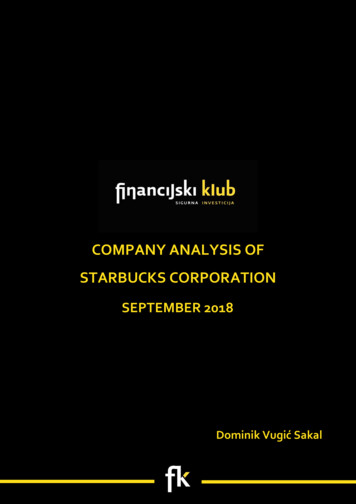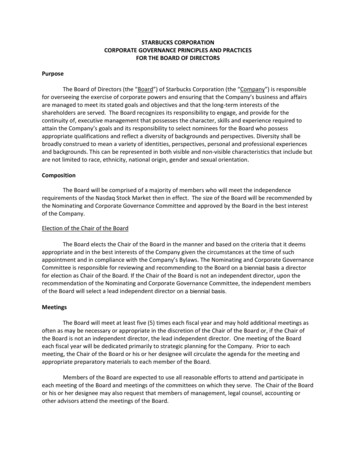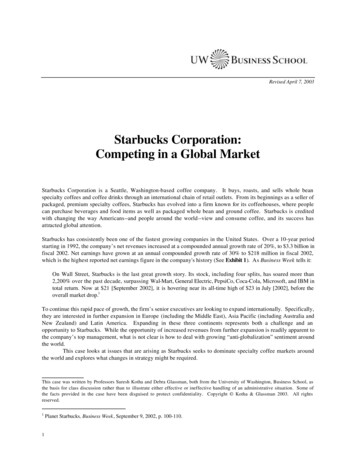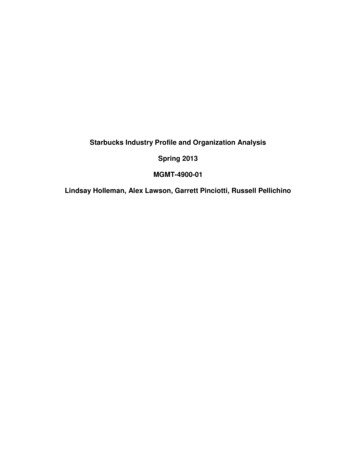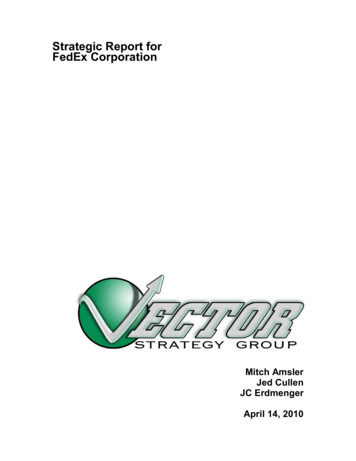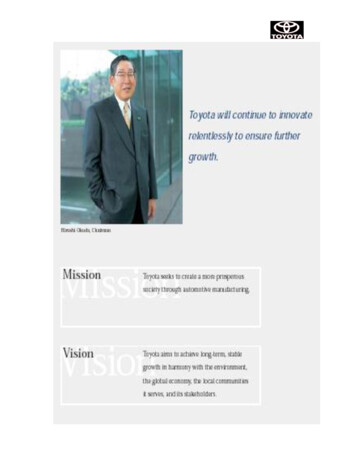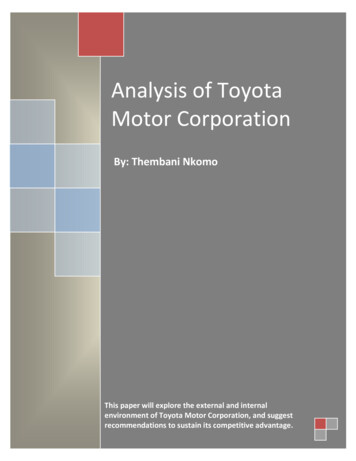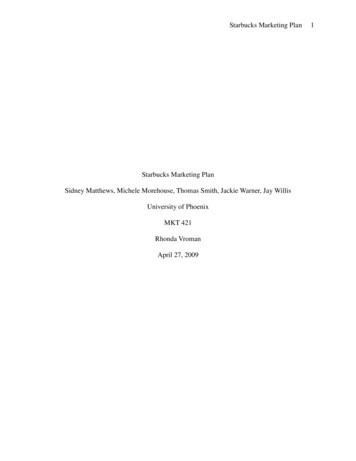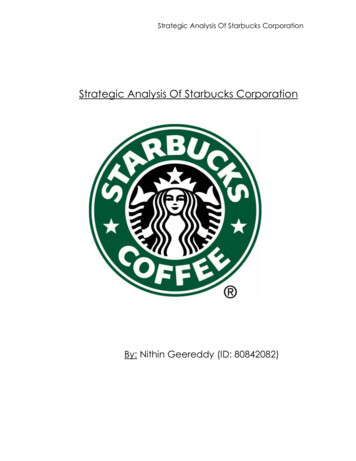
Transcription
Strategic Analysis Of Starbucks CorporationStrategic Analysis Of Starbucks CorporationBy: Nithin Geereddy (ID: 80842082)
Strategic Analysis Of Starbucks Corporation1) Introduction:Starbucks Corporation, an American company founded in 1971 in Seattle, WA, is a premier roaster, marketer andretailer of specialty coffee around world. Starbucks has about 182,000 employees across 19,767 companyoperated & licensed stores in 62 countries. Their product mix includes roasted and handcrafted highquality/premium priced coffees, tea, a variety of fresh food items and other beverages. They also sell a variety ofcoffee and tea products and license their trademarks through other channels such as licensed stores, grocery andnational foodservice accounts.1 Starbucks also markets its products mix with other brand names within itsportfolio of companies, which include Teavana, Tazo, Seattle’s Best Coffee, Starbucks VIA, StarbucksRefreshers, Evolution Fresh, La Boulange and Verismo. Starbucks had total revenue of 14.89 billion as ofSeptember 29th, 2013.22) External Environment Of The Retail Market For Coffee & Snacks:2.1) Industry Overview and Analysis:Starbucks primarily operates and competes in the retail coffee and snacks store industry. This industryexperienced a major slowdown in 2009 due to the economic crisis and changing consumer tastes, with theindustry revenue in the US declining 6.6% to 25.9 billion. Before this, the industry had a decade of growthconsistent. Due to the economic slump, consumers spent less on luxuries like eating out, choosing to purchase3low-price items instead of high-priced coffee drinks due to shrinking budgets. The industry grew at a lowannualized average growth rate of 0.9% from 2008 till 2013 with current industry revenues at 29 billion in theUS. The industry is now forecasted to grow at an annualized rate of 3.9% over the next five years, with a potentialto reach 35.1 billion revenues in the US. This growth would be mainly driven by an improving economy,increase in consumer confidence and expanding menu offerings within the industry. Starbucks dominates theindustry with a market share of 36.7%, Dunkin Brands with 24.6% and other competitors like McDonalds, CostaCoffee, Tim Horton’s etc. taking the rest as shown in Appendix 1.42.2) Industry Life Cycle and Market Share Concentration:This industry is in a mature stage with a medium level concentration. Starbucks and Dunkin Brands make upmore than 60% of the market share (Appendix 1), giving them considerable market power in determining industrytrends. Industry Structure is given in Appendix 3.2.3) Industry Demand Determinants and Profitability Drivers:The industry’s demand for premium coffee and snack products are mainly driven by a number of factors whichinclude disposable income, per capita coffee consumption, attitudes towards health, world pricing of coffee anddemographics. This industry is highly sensitive to the macroeconomic factors that affect the growth in householddisposable. During the recession, the decline in household disposable income due to increased unemployment andstagnant wages, caused a downward pressure on the revenue and profitability margins in the industry. Anothercrucial factor for analyzing the demand in the industry is the per capita coffee consumption where the increase incoffee consumption increases the revenue of coffee & snack shops. The main driver of this consumption increasewould be the increase disposable income, as the economy improves and consumers start to relax their budgets.This driver has a positive effect on market revenue. Per capita coffee consumption is expected to increase in 2014.As coffee beans are the primary input in the value chain of the industry participants, the prevailing volatile pricesof coffee beans determines market costs and profitability margins. The world price of coffee has risen sharply inrecent years due to growing demand in other countries and the resulting supply shortages. During the five years to2018, coffee bean prices are projected to decrease, which will likely translate into lower market costs and higherprofitability.5 Attitudes towards health also play an important role in determining the demand in the industry.
Strategic Analysis Of Starbucks CorporationThere is an expected shift towards healthy eating and diet among the consumers in 2014, and this could be apotential threat to the industry as they become more aware of issues related to weight and obesity. There has beena proactive shift among the industry participants to tailor their menus towards more organic and healthy productsmix.2.4) Porters Five Forces Analysis of the Retail Coffee and Snacks Industry:Threat of New Entrants: Moderate There is a moderate threat of new entrants into the industry as the barriers to entry are not high enough todiscourage new competitors to enter the market. (Appendix 2 shows Barriers to Entry Checklist). The industry’s saturation is moderately high with a monopolistic competition structure. For new entrants, the initial investment is not significant as they can lease stores, equipment etc. at a moderatelevel of investment. At a localized level, small coffee shops can compete with the likes of Starbucks and Dunkin Brands becausethere are no switching costs for the consumers. Even thought it’s a competitive industry, the possibility of newentrants to be successful in the industry is moderate. But this relatively easy entry into the market is usually countered by large incumbent brands identities likeStarbucks who have achieved economies of scale by lowering cost, improved efficiency with a huge marketshare. There is a moderately high barrier for the new entrants as they differentiate themselves from Starbuck’sproduct quality, its prime real estate locations, and its store ecosystem ‘experience’.6 The incumbent firms like Starbucks have a larger scale and scope, yielding them a learning curve advantageand favorable access to raw material with the relationship they build with their suppliers. The expected retaliation from well-established companies for brand equity, resources, prime real estatelocations and price competition are moderately high, which creates a moderate barrier to entry.Threat of Substitutes: High There are many reasonable substitute beverages to coffee, which are mainly tea, fruit juices, water,soda’s, energy drinks etc. Bars and Pubs with non/alcoholic beverages could also substitute for thesocial experience of Starbucks Consumers could also make their own home produced coffee with household premium coffee makersat a fraction of the cost for buying from premium coffee retailers like Starbucks. There are no switching costs for the consumers for switching to substitutes, which makes the threathigh. But its important to note that industry leaders like Starbucks are currently trying to counter this threatby selling coffee makers, premium coffee packs in grocery stores but this threat still puts pressure theirthe margins.Bargaining Power of Buyers: Moderate to Low Pressure There are many different buyers in this industry and no single buyer can demand price concession. It offers vertically differentiated products with a diverse consumer base, which make relatively lowvolume purchases, which erodes the buyer’s power. Even though there are no switching costs with high availability of substitute products, industryleaders like Starbucks prices its product mix in relation to rivals stores with prevailing market priceelasticity and competitive premium pricing. Consumers have a moderate sensitivity in premium coffee retailing as they pay a premium for higherquality products but are watchful of excessive premium in relation product quality.Bargaining Power of Suppliers: Low to Moderate Pressure The main inputs into the value chain of Starbucks is coffee beans and premium Arabica coffee grownin select regions which are standard inputs, which makes the cost of switching between substitutesuppliers, moderately low.
Strategic Analysis Of Starbucks Corporation Starbucks, with its size and scale, has the power to take advantage of its suppliers but it maintains a Fair tradecertified coffee under its coffee and farmer equity (C.A.F.E) program, which gives its suppliers a fair7partnership status, which yields them some moderately, low power. The suppliers in the industry also pose a low threat of competing against Starbucks by forward verticalintegration, which lowers their power. Starbucks also forms a highly important part of the suppliers business, due its size and scope, which make thepower of the suppliers lower. Given these factors, suppliers pose a moderately low bargaining power.Intensity of Competitive Rivalry: High to Moderate The industry has a monopolistic competition, with Starbucks having the largest markets share and its closestcompetitors also having a significant market share, creating significant pressure on Starbucks. Consumers do have any cost of switching to other competitors, which crates high intensity in rivalry. But its important to note that Starbucks maintain some competitive advantage as it differentiates its productswith premium products and services, which cause a moderate level of intensity in competition. The industry is mature and growth rate has been moderately low which cause the intensity of competitionamong the companies to be moderately high due to all of them seeking to increase market shaper fromestablished firms like Starbucks. This industry does not have over capacity currently and all these factors contribute to the intensity amongrivals to be moderately high.Looking at the Porters five forces analysis, we can get an aggregate industry analysis that the strength of forcesand the profitability in the retail coffee and snacks industry are Moderate.3) Internal Analysis of Starbucks Corporation:3.1) Starbucks Core Competence:The core competence of Starbucks has been its ability to effectively leverage their cornerstone productdifferentiation strategies by offering a premium product mix of high quality beverages and snacks. Starbuck’sbrand equity is built on selling the finest quality coffee and related products, and by providing each customer aunique “Starbucks Experience”, which is derived from supreme customer service, clean and well-maintainedstores that reflect the culture of the communities in which they operate, thereby building a high degree ofcustomer loyalty with a cult following. Its other core competence is its human resource management's valuesbased approach for building very strong internal and external relationships with suppliers, which drives thesuccessful deployment of its business strategy of organic expansion into international markets, horizontalintegration through smart acquisitions and alliances that maintains their long-term strategic objective being themost recognized and respected brands in the world.3.2) Starbucks SWOT Analysis:Strengths: Strong Market Position and Global Brand Recognition: Starbucks has a significant geographical presenceacross the globe and maintain a 36.7% market share in the United States (Appendix 1) and has operations inover 60 countries. Starbucks is also the most recognized brand in the coffeehouse segment and is ranked 91st inthe best global brands of 2013.8 Starbucks effectively leverages its rich brand equity by merchandizingproducts, licensing its brand logo out. Such strong market position and brand recognition allows the companyto gain significant competitive advantage in further expanding into international markets and also help registerhigher growth in both domestic and international markets. Over the years, they have achieved significanteconomies of scale with superior distribution channels and supplier relationships. Products of the Highest Quality: They give the highest importance to the quality of their products and avoidstandardization of their quality even for higher production output.9
Strategic Analysis Of Starbucks Corporation Location and Aesthetic appeal of its Stores: Starbucks has stores in some of the most prime and strategiclocation across the globe. They target premium, high-traffic, high-visibility locations near a variety of settings,including downtown and suburban retail centers, office buildings, university campuses, and in select rural andoff-highway locations across the world.10 This has earned them a significant competence and advantage to beable to penetrate prime markets and tap into customers convince factor. Their stores are visually appealing andhave a ‘cool’ factor attached to it with being designed to reflect the unique character of the neighborhood theyserve in and environmentally friendly. They provide free wifi, great music, great service, warm atmosphereand provide an environment of community meeting spot, which forms a wider part of the ‘StarbucksExperience’. The main aim for the firm is to make their stores a ‘third place’ besides home and work.11 Human Resource Management: Starbucks is know for its highly knowledge base employees. They are themain assets of the company and they are provided with great benefits like stock option, retirement accountsand a healthy culture. This effective human capital management translates into great customer services. It wasrated 91st in the 100 best places to work for by Fortune Magazine.12 Goodwill among consumers due to Social Responsibly Initiatives: Their stores are community friendly,focused on recycling and reducing waste. They build goodwill among communities where they operate.13 Diverse Product Mix: Starbuck portfolio of products given in Appendix 8, that caters to all age groupsdemographic factors.14 Use of Technology and Mobile Outlets: Starbucks efficiently leverages technology with its mobile application“Starbucks App’ in both apple and android software’s. They make significant investments in technology to15support their growth every year. Customer base loyalty: Starbucks has cult fo
Strategic Analysis Of Starbucks Corporation Starbucks, with its size and scale, has the power to take advantage of its suppliers but it maintains a Fair trade certified coffee under its coffee and farmer equity (C.A.F.E) program, which gives its suppliers a fair partnership status, which yields them some moderately, low power. 7

